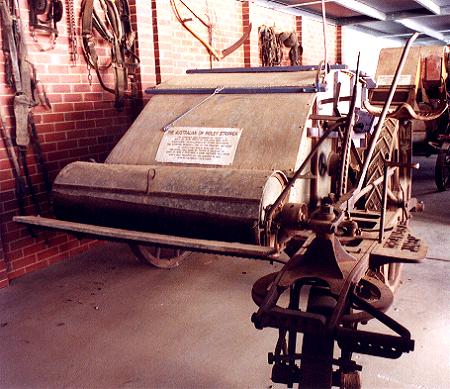These factors encouraged individuals to look to machines
to do the work and one of the earliest and most successful
was John Ridley. Ridley, born in May 1806 at West Bolden
DUR, arrived 17 Apr 1840 on the Warrior with his
wife, Mary nee Pybus and two daughters. He established
himself
at Hindmarsh as a flour miller with the first steam mill
at a time when this region of the Adelaide plains was the
cereal
growing
region
of
the colony.
In late 1843, he developed the harvest stripper. Essentially
it was a box with a comb mounted in front and a rotating
beater placed behind the comb. As the stripper was pushed
through the crop by horses, the wheat heads were drawn
through the comb and then removed by the beater and collected
in the box. The resultant mixture of grain and chaff was
then separated in a small stationary winnower.
In South Australia’s hot, and dry climate where the
grain ripened on the stalk. the stalk was of little value
and thus the stripper represented a major advance as previously
the harvesting of wheat was done by hand with a sickle,
followed by stooking, drying, stacking and threshing. The
other great advantage was the simplicity of the design
which meant that the stripper could be manufactured easily
in small, local engineering works.
By 1857, half of the South Australian wheat crop was being
harvested by machine. The significance of Ridley’s
contribution to the colony’s economy cannot be under
estimated.
John Ridley returned to England in 1853 although he still
retained ownership of property in South Australia (know
known as Ridleyton) He died in London 25 Nov 1887. |
In 1843 the SA Corn Exchange Committee
offered a prize of £40
to anyone submitting a model or plans of a reaper of which
the committee would approve. On 23 Sep 1843 it was
reported that several unsuccessful models and plans had
been submitted.
Ridley
had not participated but he had been constructing
a machine, and on 18 Nov 1843 the Adelaide Observer
announced that, a further trial of Mr Ridley's machine
has established its success.
Ridley was greatly worried in later years by J Wrathall
Bull's claim that he was the real inventor of Ridley's reaping
machine. He was one of the men who had
sent in models that were rejected by the committee.
He said that Ridley had seen his model and constructed his
machine on its principles. Ridley's denial is borne
out by the fact that his machine had had two successful
trials within two months of the models being exhibited
and in those days a machine could be constructed in Adelaide
only by primitive methods, and it would not have been
possible to make a working machine
in such a short period. |